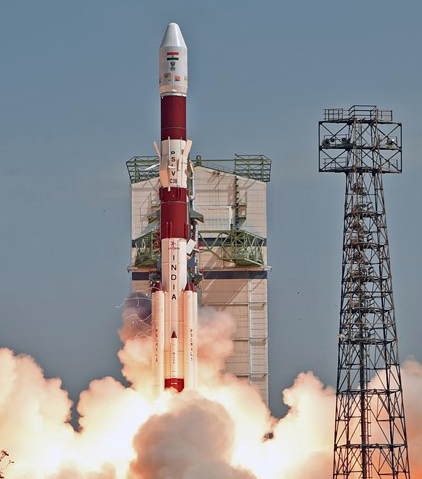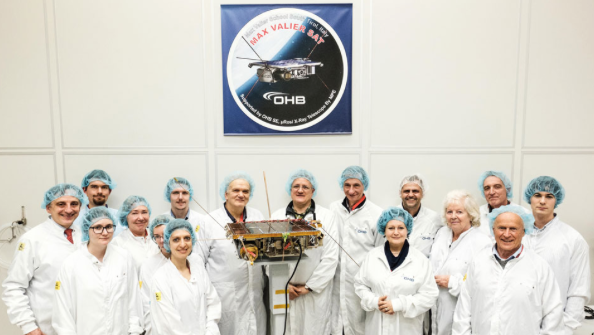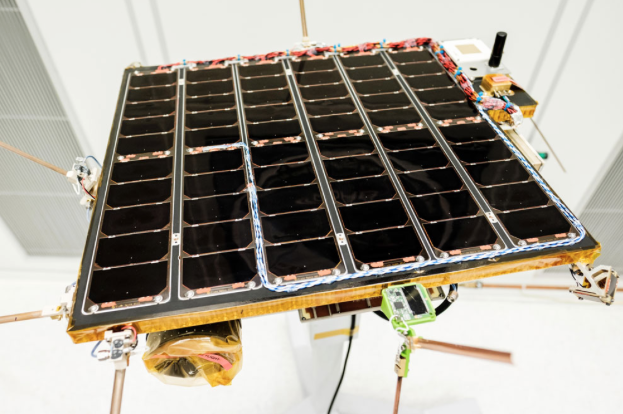This has been one busy week and weekend with a myriad of launches around the world. This launch comes from the heart, as it was financed by OHB founder Christa Fuchs and her late husband, Prof. Dr. h.c. Manfred Fuchs, who initiated and financed the project together with the state government of South Tirol. The following is their statement regarding the launch.
On June 23 at 6.00 hours CEST, “Max Valier Sat”, a satellite for school students and amateur radio users, was launched on board an Indian PSLV rocket lifting off from the Dhawan Space Centre around 80 kilometers north of Chennai. Working closely with teachers and school students from the Technology College (TFO) of Bolzano, South Tirol, specialists from Bremen-based space company OHB System AG developed and built this nano-satellite. One particular highlight is the mini x-ray telescope added to the mission by the Max Planck Institute of Extraterrestrial Physics (MPE) in Garching.
The team were elated when “Max Valier Sat” emitted its first sign of life after being released into its target polar orbit at an altitude of a good 500 kilometers.

Launch of PSLV-C38. Copyright: ISRO
Evolution of a satellite for school students
OHB founder Christa Fuchs and her late husband, Prof. Dr. h.c. Manfred Fuchs, initiated and financed the project together with the state government of South Tirol. South Tirol was where Manfred Fuchs came from and is a region with which he maintained close contacts throughout his life. A visit to his former school, the “Max Valier” TFO in Bolzano, in 2008 kicked off the project. Since then, OHB has been helping teachers and students in realizing their dream of building their own satellite as a unique teaching method. “This project was particularly close to my husband’s heart. Knowing that this satellite is now in orbit is a fitting memorial to him and his commitment to his home in South Tirol,” says Christa Fuchs. The director of TFO Bolzano, Dr. Barbara Willimek, is watching what is going on at the ground station at her school. “We have all been working on this special project with great enthusiasm since 2008. It has become a really complex satellite and I am pleased that all the efforts have paid off and “Max Valier Sat” is now in orbit. This is a fantastic success for our teachers and students.”
Growing complexity
Initially, a simple satellite model capable of mastering the basics was planned. However, this quickly changed when the MPE offered the µROSI x-ray satellite as a payload. The purpose of this mission is to explore the entire heavens to search for at least 100 light sources in the soft x-ray range. The difference is that this time the data will be available not only to scientists but also to hobby astronauts. The satellite with the call sign II3MV will be transmitting its data unencrypted on the amateur radio frequencies 145.860 MHz and 145.960 MHz.

The Max Valier Sat team at the Launch Readiness Review end of February at OHB in Bremen. Copyright: Karlis Kalnins
With the inclusion of the telescope, the “Max Valier Sat” grew enormously in complexity, of course, as it requires precise pitch control mechanisms so that it can be aligned accurately and kept stable in space. At the same time, OHB developed an outer casing for the nano-satellite that already integrates the electronic boards. A number of structural components were made from special materials using 3D printing and will be tested and qualified on this mission for future use in larger satellites. The compact solution for the structure ensures substantial weight reductions and saves a large amount of space. As the project team did not want this capacity to go to waste, further experiments were added.

The high-tech nano-satellite “Max Valier” in the cleanroom of Bremen based space technology company OHB System. Copyright: Karlis Kalnins
Team spirit and technology
The payloads came from all parts of the OHB Group and testify to a true team spirit. Thus, Swedish company ÅAC Microtec is testing the on-board computer for the MATS research mission that it is developing in conjunction with OHB Sweden for the InnoSat microsatellite. In addition, ÅAC has contributed a newly developed TDRS modem. TDRSS stands for “Tracking and Data Relay Satellite System” and is used only by NASA and the US government to send data from low-orbiting satellites to the ground via geostationary satellites more swiftly and reliably.
OHB System provided the “Software Defined Radio” technology experiment which in contrast to conventional transmitters is not rigidly oriented to a narrow frequency range but can be reprogrammed and updated in space. An AIS receiver from Luxspace for picking up and processing global ship data is also included in the high-tech package. Last but not least, “Max Valier Sat” also contains preliminary prototypes of the “Sprites” chips sets from the major Breakthrough Startshot project. With a size of only 3.5 square centimeters and a weight of just four grams, thousands of the nano-spacecraft are to be sent to Alpha Centauri in around 20 years’ time.


